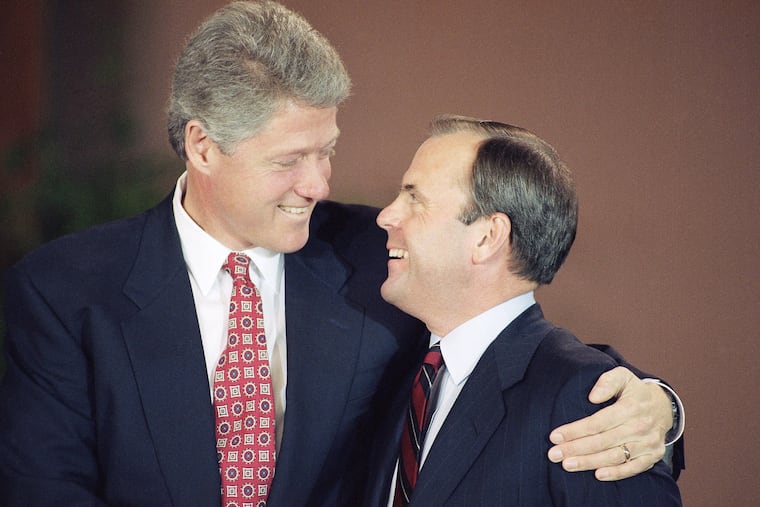Four takeaways on the new USMCA trade deal from a NAFTA expert
"On balance, this was a reasonable approach to updating the NAFTA, which it needed to be updated," said political insider Mack McLarty. "It was 25 years old, there wasn't an internet when this was created, and like any agreement, it needed to be updated."

Almost no one knows trade agreements better than Arkansas car dealer and political insider Mack McLarty.
McLarty has advised several presidents on trade: Jimmy Carter and George H.W. Bush (the initial force behind the North American Free Trade Agreement); and childhood friend President Bill Clinton (McLarty served as his White House chief of staff).
Today, McLarty is chairman of McLarty Cos., a fourth-generation family-owned dealership business in Little Rock. He also is chairman and cofounder of advisory firm McLarty Associates in D.C.
In 1993, he worked with Clinton to finalize and ferry NAFTA through Congress.
"We had to get our economic plan passed first," McLarty told the Free Press on Wednesday. "We got that done. Then, we started on NAFTA in early summer."
Congress passed NAFTA in early fall of 1993 and McLarty proudly noted that it passed on a "bipartisan basis."
The agreement "was very important, it was a critical element that showed sustained engagement by the United States with Canada and Mexico," McLarty said. "It strengthened the North American platform and competitiveness, while improving the relationships between the three countries."
So on Oct. 1, when McLarty heard the news that an updated trade pact had been reached with Canada and Mexico, he said he let out a sigh of relief.
"On balance, this was a reasonable approach to updating the NAFTA, which it needed to be updated," said McLarty. "It was 25 years old, there wasn't an internet when this was created, and like any agreement, it needed to be updated."
While some analysts continue to study the 1,000-page trade deal called the United States-Mexico-Canada Agreement, McLarty has digested most of it. Here are some of his key thoughts.
On what the agreement covers
The 1993 NAFTA needed more "content" such as opening up the agreement to agriculture and to address jobs and technology updates, McLarty said.
The USMCA achieves those upgrades.
In a Free Press op-ed he cowrote last month, McLarty said that NAFTA was one of the first examples of a consistent and bipartisan consensus on trade policy.
But it was "badly frayed over the years" and there has been ongoing dialogue over how to best construct trade policy to benefit American workers and farmers.
"On balance," McLarty said, the new agreement "shifts incentives to have more content in the United States and more production in United States."
For example, the new deal calls for 70-to-75 percent of a car's content to originate in USMCA countries. Auto tariffs won't affect Canada and Mexico unless their exports to the United States top 2.6 million units a year. Analysts say Canada will be able to export $32.4 billion in parts while Mexico can export $108 billion in parts to the United States.
On U.S. wages
The new agreement does call for higher wages for autoworkers — but autoworkers in the United States won't necessarily see them, McLarty said.
Starting in 2020, the agreement requires that 30 percent of vehicle production must be done by workers earning an average production wage of at least $16 an hour. That's about three times the pay of the average Mexican autoworker, and in 2023, the production percentage rises to 40 percent.
The $16 an hour wage favors Mexican workers more than it does U.S. workers, he said.
McLarty said, "Most U.S. workers are earning over $16 an hour now."
On U.S. jobs
But the wage increase does discourage manufacturers from moving their factories to Mexico for the purpose of paying lower wages, McLarty said.
"So that has the potential of keeping some jobs in the U.S.," he said.
The flip side to that, though, he said is that keeping car production in the U.S. where costs are higher will likely lead to "a moderate increase in the prices of some automobiles."
On tariffs and relationships
No "major" harm was done to the initial trade agreement's tenets, he said. The agreement keeps the North American supply chain intact and North America will continue to be more competitive in the world, McLarty said.
And while previously announced steel and aluminum tariffs remain in place for now, the agreement would stop the imposition of the 25-percent tariffs President Trump had threatened on imported vehicles from Canada and Mexico.
That last point gives carmakers a sense of calm and confidence in the future, he said.
"Certainty is so important in business, in terms of investment, and the fact that it's concluded is so important for all three countries," McLarty said.
But USMCA could have achieved "what appears to be a constructive outcome in a much less dramatic and confrontational manner," he said.
"There has been harm done to our relationship with Canada and Mexico," said McLarty. "This was a solution in search of a problem."
One benefit to the USMCA, say analysts, is there is a 16-year term to it. It calls for a review every six years to tweak problems. That's important given the evolution of self-driving cars and electric vehicles that likely will impact the future auto industry supply chain and marketplace, analysts say.
All considered, McLarty said the glass is half-full, given that the USMCA "didn't break the glass. Had no agreement been reached at all, there would have been big disruption in trade and that would have been a setback."